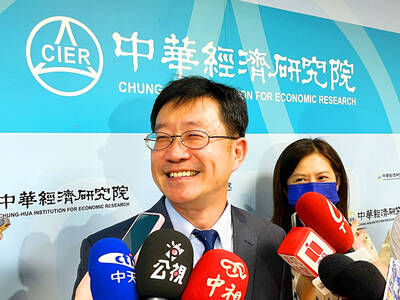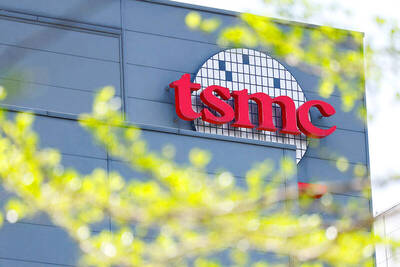Despite a consensus on growing downside risks to the economy following last week’s unexpected cuts in interest rates, economists are divided over whether the cuts represented a temporary response or a shift in the central bank’s monetary policy.
Standard Chartered Bank said the central bank’s decision to lower the discount rate by 12.5 basis points to 3.5 percent on Friday — just one week after it reduced reserve requirements for banks — put an end to the central bank’s four years of tight monetary policy because of widespread concern that the economic slowdown could deepen.
Assuming that inflation pressure continues to subside in the medium-term, Standard Chartered predicted in a report released on Friday that the central bank would opt for three consecutive rate cuts of 12.5 basis points in December, March and June, bringing the discount rate to 3.125 percent.
Standard Chartered economists Tony Phoo (符銘財) and Nicholas Kwan (關家明) said in the report that the rate cut aimed to boost market confidence after the US financial crisis took its toll on local equity prices.
The local stock market has slumped 30 percent since the beginning of the year, weakening public confidence in President Ma Ying-jeou’s (馬英九) government, which vowed to make the economy a top priority if elected.
“The unexpected move, in our view, clearly reflects increasing concern among policymakers that the current bouts of global liquidity and the credit crunch could potentially impact Taiwan’s economy,” they wrote.
Sherman Chan (陳穎嘉), an economist at Moody’s Economy.com, was skeptical about whether the rate cut would have the desired effect. She said, however, that the central bank had clearly abandoned its trend of monetary tightening, albeit much sooner than expected.
“Although the modest 12.5 basis point interest rate cut this [last] week may do little to boost the economy, it is a clear indication that the Taiwanese authorities are now concerned about growth,” Chan wrote in a report on Friday.
Most other central banks in the Asia-Pacific region are expected to gravitate toward a neutral stance or loosen monetary policy, as inflation across the region should decelerate in the fourth quarter, the Sydney-based economist said.
Considering sluggish domestic demand and the unpromising global outlook, Citigroup said in a report on Friday that the domestic economy may slow further in the second half of the year, but said the current downturn would be “shallow but protracted” and last week’s cut could be temporary.
Cheng Cheng-mount (鄭貞茂) and Tina Liao, two Citigroup economists who coauthored the Citi Investment Research report distributed to clients, said the central bank’s latest rate cut was meant to “preemptively stabilize domestic financial markets,” adding that any future rate cuts would be contingent on the development of the global financial situation.
“Looking ahead, we think the central bank will likely take a neutral stance on monetary policy and stay put for a couple of quarters,” they wrote. “Nonetheless, we think current policy rates are still accommodative and policymakers will likely go back to tightening [monetary policy] once the economy shows more signs of recovery in 2009.”

WEAKER ACTIVITY: The sharpest deterioration was seen in the electronics and optical components sector, with the production index falling 13.2 points to 44.5 Taiwan’s manufacturing sector last month contracted for a second consecutive month, with the purchasing managers’ index (PMI) slipping to 48, reflecting ongoing caution over trade uncertainties, the Chung-Hua Institution for Economic Research (CIER, 中華經濟研究院) said yesterday. The decline reflects growing caution among companies amid uncertainty surrounding US tariffs, semiconductor duties and automotive import levies, and it is also likely linked to fading front-loading activity, CIER president Lien Hsien-ming (連賢明) said. “Some clients have started shifting orders to Southeast Asian countries where tariff regimes are already clear,” Lien told a news conference. Firms across the supply chain are also lowering stock levels to mitigate

IN THE AIR: While most companies said they were committed to North American operations, some added that production and costs would depend on the outcome of a US trade probe Leading local contract electronics makers Wistron Corp (緯創), Quanta Computer Inc (廣達), Inventec Corp (英業達) and Compal Electronics Inc (仁寶) are to maintain their North American expansion plans, despite Washington’s 20 percent tariff on Taiwanese goods. Wistron said it has long maintained a presence in the US, while distributing production across Taiwan, North America, Southeast Asia and Europe. The company is in talks with customers to align capacity with their site preferences, a company official told the Taipei Times by telephone on Friday. The company is still in talks with clients over who would bear the tariff costs, with the outcome pending further

Six Taiwanese companies, including contract chipmaker Taiwan Semiconductor Manufacturing Co (TSMC, 台積電), made the 2025 Fortune Global 500 list of the world’s largest firms by revenue. In a report published by New York-based Fortune magazine on Tuesday, Hon Hai Precision Industry Co (鴻海精密), also known as Foxconn Technology Group (富士康科技集團), ranked highest among Taiwanese firms, placing 28th with revenue of US$213.69 billion. Up 60 spots from last year, TSMC rose to No. 126 with US$90.16 billion in revenue, followed by Quanta Computer Inc (廣達) at 348th, Pegatron Corp (和碩) at 461st, CPC Corp, Taiwan (台灣中油) at 494th and Wistron Corp (緯創) at

NEGOTIATIONS: Semiconductors play an outsized role in Taiwan’s industrial and economic development and are a major driver of the Taiwan-US trade imbalance With US President Donald Trump threatening to impose tariffs on semiconductors, Taiwan is expected to face a significant challenge, as information and communications technology (ICT) products account for more than 70 percent of its exports to the US, Chung-Hua Institution for Economic Research (CIER, 中華經濟研究院) president Lien Hsien-ming (連賢明) said on Friday. Compared with other countries, semiconductors play a disproportionately large role in Taiwan’s industrial and economic development, Lien said. As the sixth-largest contributor to the US trade deficit, Taiwan recorded a US$73.9 billion trade surplus with the US last year — up from US$47.8 billion in 2023 — driven by strong